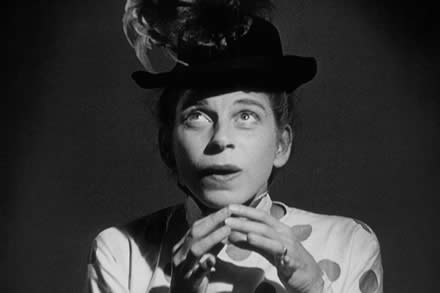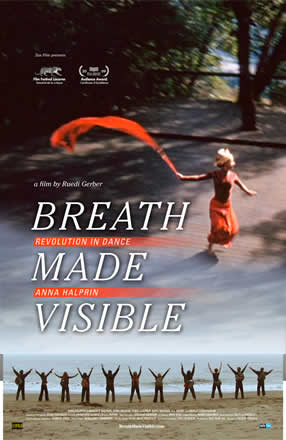 Swiss actor-filmmaker Ruedi Gerber’s inspiring tribute to modern dance pioneer Anna Halprin portrays the visionary dancer who’s still making an impact into her 90’s. Gerber brackets his fascinating archival footage with Halprin’s autobiographical solo performance at the Joyce Theatre. Watching the rambunctious 86 year-old Anna Halprin acts and dance across stage is riveting.
Swiss actor-filmmaker Ruedi Gerber’s inspiring tribute to modern dance pioneer Anna Halprin portrays the visionary dancer who’s still making an impact into her 90’s. Gerber brackets his fascinating archival footage with Halprin’s autobiographical solo performance at the Joyce Theatre. Watching the rambunctious 86 year-old Anna Halprin acts and dance across stage is riveting.
She danced since a child, in love with movement. An image of young Anna’s clowning on her bike is narrated, “Riding my bicycle, feeling like a bird flying…I am an ecstatic bird flying.”
Tyro dancer Halprin’s comic Chaplin-moves in James Broughton’s “Golden Positive” introduces us to the radical woman who put the “new” in new-age.
An Illinois native, Halprin watched her Hasidic grandpa dance his celebration of God. That mystical yearning proved fundamental to her way of work which incorporated ideas from Ruth St, Denis Martha Graham, Doris Humphrey and her University of Wisconsin teacher Margaret H’Doubler.
“I went to new York to join the Humphrey Wideman Company.” She discovered her flair for comedy dancing with the company on Broadway, giving credit to her naturally funny father (who we see clowning in home movies, and whose effect we see in many clips of Anna’s dances.
When she married famed modernist landscape architect Lawrence Halprin (FDR memorial-Washington, D.C.) she moved to San Rafael, Marin County.
The move changed her practice. “I became more physically oriented looking for something more like nature itself. I wanted to dance about real things that were real in my life.”
Larry and Anna collaborated, exploring the way people move through space. “Dance has to do with the life around us on this planet” explains Larry, who championed human scale works and developed the “playable” civic fountains that became fashionable in the 70’s. Interested in community building, they developed a score-based interdisciplinary creative process (the RSVP Cycle) based on kinesthetic awareness. The enormous redwood deck they built became the temple of Halprin’s dance practice where she made “sense of the mystery of life.”
She became a conduit, a medium channeling the flow of nature into movement, merging her social activism with soulful expression. Over the years artists as diverse as Luciano Berio, Terry Riley, LeMonte Young,  and Morton Subotnick, Robert Morris, Robert Whiteman, Richard Brautigan, James Broughton, Michael McClure, Eiko and Koma, and Min Tanaka used her haven to explore and develop their work. Her students include Trisha Brown, Meredith Monk, Yvonne Rainer, Simone Forti, Ruth Emmerson and Sally Gross- many of the postmodern dancers of the Judson Church Group.
and Morton Subotnick, Robert Morris, Robert Whiteman, Richard Brautigan, James Broughton, Michael McClure, Eiko and Koma, and Min Tanaka used her haven to explore and develop their work. Her students include Trisha Brown, Meredith Monk, Yvonne Rainer, Simone Forti, Ruth Emmerson and Sally Gross- many of the postmodern dancers of the Judson Church Group.
The Halprin’s growing girls joined in and eventually joined Anna’s first company. Footage from the fifties, showing her dancing with her daughters, is remarkable. “Anna included us in her artist life. She formed a children’s dance co-op. We’d dance everyday. She encouraged us to tell our own stories.” Daria explains.” Most little girls studied ballet. I wanted to be that girl with the petty pink tutus. It was not a normal life. Friends weren’t allowed. It was confusing. Sometimes it was heaven on earth.” Dancing a pas de deux with John Graham, Daria had to trust him and his oft-risky moves.
To the sound of ankle bells we watch her whirl on the deck in her mesmerizing 1955 “The Prophetess”, described by John Graham as “a simple circling movement which began in her hands and continued to go through the body.” “More than a dance idea” she got to “the essential.”
Performing at the Anti-Festival in NY, in 1955, Anna was offended by the sense that all the dance companies used look a likes, dancers who looked and danced like the choreographer.
She decided to reinvestigate the purpose of dance. The San Francisco Dancers Workshop, formed in 1955 with A.A. Leath and John Graham, broke as many barriers as it could. “We questioned the role of the dancer. We could speak sing, sculpt.” They co-created without a choreographer. “Using yourself beyond your limits” she explains describing their work. “I feel a connection, to a tree to the sky, the earth like a Calder sculpture. We let a change occur when we are working in it.”
 Invited to Venice Fest (1963) by composer Lucianio Berio, the company performed “Esposizioni” climbing through cargo nets and invading the theatre (years before “Hair”). Angry audience members at La Fenice Opera House threw shoes, exclaiming, “For this Columbus discovered America?”
Invited to Venice Fest (1963) by composer Lucianio Berio, the company performed “Esposizioni” climbing through cargo nets and invading the theatre (years before “Hair”). Angry audience members at La Fenice Opera House threw shoes, exclaiming, “For this Columbus discovered America?”
Seeing an “establishment man in the room, Halprin angrily tore off her clothes. Seeing him cry at her provocation made her rethink things. Period footage of her company reverently stripping to Petula Clark’s “Downtown” shows the groundbreaking “Parades and Changes“(1965) again pre-dating “Hair” and the Living Theatre’s “Paradise Now.”
Worked with Fritz Perls, the Gestalt therapist, she linked movement and released emotion. The theatre world embraced her. The modern dance community rejected her.
After eighteen years together, the original trio explored their real relationship In “Apartment 6”. When Halprin became interested in Ritual dance, she lost her two original “playmates.”
Sitting with her old partners, she admits, “It was like a divorce to me. I was never able to go back to performing the way I had. Like Seinfeld… when they go off by themselves it doesn’t work.
Invited to LA after the Watts riots in 1965, Halprin created the first interracial dance company in the country, rife with the sexual tension of unresolved racism, as evocative footage reveals.
Present day scenes of the still active Halprin blend with interviews: Larry Halprin (who died last October) and Merce Cunningham (who also died last year) and daughters psychologist/ actress Daria (“Zabriskie Point“) and art therapist/ Romani activist Rana.
Colon cancer survivor Halprin’s life and art are deeply entwined. Suspecting her colon cancer from a drawing she had made, Anna danced her way to remission with a healing ritual. Her daily visits to her dying husband in the ICU inspired” Intensive Care: Reflections on Death And Dying.” She’s applied her Five Stages of Healing to large-scale community pieces. She teaches seniors to dance in wheelchairs and works with aid’s patients.
Explaining the title she says, “I’ve always said that dance is the breath made visible. Once you stop breathing and the breath is no longer visible, you stop moving.” Halprin’s joy is palpable in every sequence of the film. SEE.

